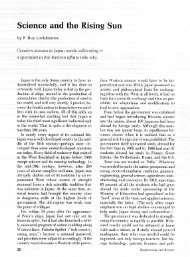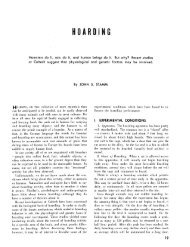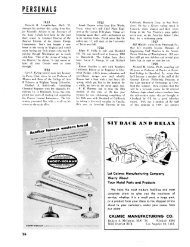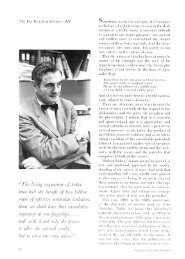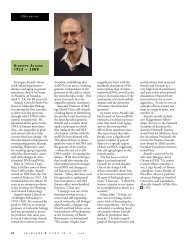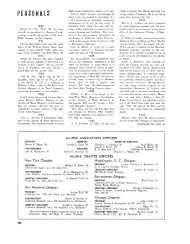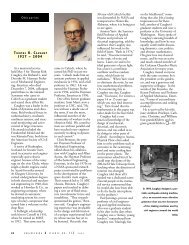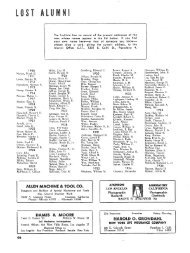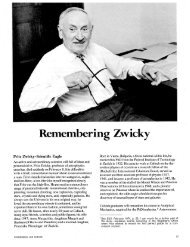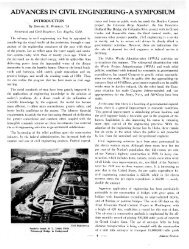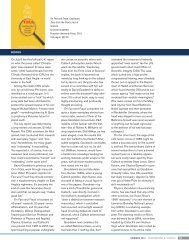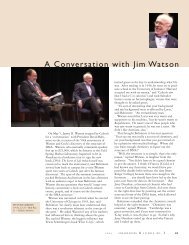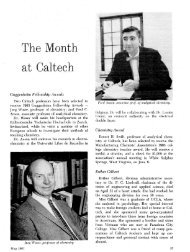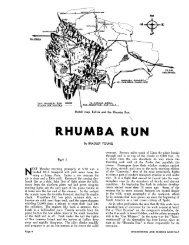The First Operation Under Ether - Engineering & Science
The First Operation Under Ether - Engineering & Science
The First Operation Under Ether - Engineering & Science
You also want an ePaper? Increase the reach of your titles
YUMPU automatically turns print PDFs into web optimized ePapers that Google loves.
'0<br />
Below: In <strong>The</strong> <strong>First</strong> <strong>Operation</strong> <strong>Under</strong> <strong>Ether</strong> (painting by Robert Hinckley), wh ich took place<br />
in Boston on October 19, 1846, William Morton demonstrated the anesthetic properties of<br />
ether during jaw surgery. Courtesy of the Boston Medical Library in the Countway Library<br />
of Medicine, Boston, Massachusetts.<br />
ENGINEERIN G & SC I EN({ No.2
Mesmerism<br />
and the<br />
Introduction<br />
of Surgical<br />
Anesthesia<br />
to Victorian<br />
England<br />
by Alison Winter<br />
Above: <strong>The</strong> most famous<br />
Victorian mesmerist, John<br />
Elliotson, is portrayed in a<br />
1943 Punch cartoon 35 a<br />
concert pianist, "playing"<br />
the head of a plebeian<br />
woman with mesmeric<br />
influences, as if her brain<br />
were a set of piano keys.<br />
One of the most celebrated moments in the hisco ry of surgery is the<br />
introduction of anesthesia in [he 19th century. During the 18405, eeher,<br />
choroform , and then nitrous oxide were first used in surgical practice as<br />
anesthetic agents. Historians have traditionally seen this innovation as the<br />
([itical moment in an age-old battle between doctors and pain. I'm going to<br />
make an argument, however, that might initially seem boch ungenerous and<br />
conerary to common sense: I'll suggest tbat the incroduccion of anesthetic<br />
techniques in the 1840s certainly had something m do with the alleviation of<br />
pain, but a much more importam facmr was the professional anxieties of<br />
Victorian doctors and their struggles for authority at a critical moment in<br />
cheir hisrory. <strong>Ether</strong> was introduced as an alternative to a preexisting anesthetic<br />
technique that was threatening ro many doctors-the praccice of<br />
mesmerism.<br />
In the first half of the 19th century, British physicians and surgeons were<br />
ostensibly governed by three organizations- the Royal College of Physicians,<br />
the College of Surgeons, and the Society of Apothecaries-but actually there<br />
was very little regulation. Early Victorian docrors often claimed that they<br />
were making great strides in clinical research and medical education, but they<br />
were by no means a united and powerful community: there were few legal<br />
regulations over medical practice, and a wide variety of competing healers<br />
offered their services in a chaotic medical marketplace. And Victorian patients<br />
were less impressed with the progress of medicine than doctors themselves.<br />
Medical students were caricatured in the press as drunken buffoons, and it was<br />
commonly said that doctors' ignorance and irresponsibility made them as<br />
likely to kill as they were to cure their patients.<br />
<strong>The</strong>re were constant complaints about "quackery," bur these complaints<br />
came fwm so many different sources as to suggest that the problem was .<br />
ubiquitous-there was no single type of praccitioner one could seek out who<br />
was sure to be trustworthy. <strong>The</strong>re were "quacks" with formal medical training<br />
and without it, in the metropolis and in the provinces, on the faculty of the<br />
universities, and engaged in private pcaccice. Conventional donors were<br />
accused of quackery, as well as people we might now identify as fringe or<br />
alternative therapists, such as homeopathists, herbalists, hydrotherapists,<br />
mesmerists, and hypnotists. But calling them fringe therapists would be<br />
anachronistic, because the situation was so chaotic in early Victorian England<br />
ENGINHRING & SCIENCE NO. 2 JI
To prove t hat the ordinary senses were really gone, the mes merist and members<br />
of the audience fired p istols neat rh e subject's ears, pricked her skin with<br />
Right: A mesmerist creates<br />
a state of unconsciousness<br />
in his subject by moving<br />
his hands closely over her.<br />
Below: Here the magnetic<br />
influence is rendered<br />
visible (by the imagination<br />
of the artist) as a physical<br />
force radiating from the<br />
mesmerist's body into that<br />
of his subject. (Both<br />
illustrations from Charles<br />
Dupotet, L'Art du<br />
Magnetiseur, 1862.)<br />
needles. . and waved smel li ng salts beneath her nostrils.<br />
that they were not really marg inal at all-they<br />
were just part of the fray.<br />
Among them, the mesmerists were particularl y<br />
significant to the history of anesthesia. Animal<br />
magnetism, or mesmerism, was a practice in<br />
which one person claimed to influence another<br />
through the movement of his hands near the surface<br />
of tbe other person's body. It was invented in<br />
the late 18th century by the Austrian physician<br />
Franz Anton Mesmer, who thought that he had<br />
discovered a means of manipulating physical<br />
forces, or "mag netic fluids," in the service of<br />
health.<br />
Mesmer and his followers thought that when the<br />
mesmerist moved his hand in front of the patient,<br />
a physical influence of some kind passed between<br />
them. <strong>The</strong> influence created physiological changes<br />
in the patient's body. Mesmerism was controversial<br />
from the very beginning, but it survived and<br />
spread throughout Europe. In the 19th century, it<br />
became a widespread form of psychological experiment<br />
and medical therapy. In the illustration<br />
ENGINEERING & HI EN (E No.2<br />
above, a mid-19th-century mesmerist moves<br />
closely over his subject, his physical proximity<br />
creating a state of artificial sleep or altered consciousness;<br />
the illustration below portrays the<br />
mag netic influence as a kind of ray. akin to light.<br />
Once the mesmeric state had been achieved,<br />
further manipulations could cure illnesses, or.<br />
alternatively, produce amazing psychical phenomena<br />
such as clairvoyance, prophecy, and the<br />
suspension of sensation.<br />
During the 1840s, hundreds of itinerant mesmerists<br />
traveled along Britain's lecturing ci rcuits,<br />
displaying thei r phenomena before paying audiences.<br />
<strong>The</strong>y used public shows to attract private<br />
clients who might be willing to pay large sums for<br />
personal treatment. During the public demonstrations,<br />
mesmerists and skeptics would tussle over<br />
the question of whether the strange phenomena<br />
were real or the subject were faking. This was the<br />
first question people asked, and they went to<br />
extravagant and sometimes horrifying lengths to<br />
answer it.<br />
To prove that rhe ordinary senses were really<br />
gone, the mesmerist and members of the audience<br />
fired pistols near the subject's eats, pricked her<br />
skin with needles (the stereotypical patient was<br />
always a woman, although mesmerism was<br />
praticed on both genders), and waved smelling<br />
salts beneath her nostrils. <strong>The</strong>re were more<br />
aggressive tests as well: acid poured on her.skin,<br />
knives thrust under her fingernails, electric shocks<br />
run through her arms, and noxious substances<br />
placed in her mouth (such as vinegar, soap, and<br />
even ammonia). Experiments somerimes provoked<br />
physical skirm ishes over subjects' bodies as the<br />
mesmerist and his challengers in flicted ri val<br />
tortures. If these produced a response. skeptics<br />
dismissed the experi ment. If there was none, the<br />
trance was all the more piausible--{)r the fakery all<br />
the more skillful and reprehensible.<br />
This was bow mesmerism's anesthetic powers<br />
were discovered. After dozens of public demon-
talked reform but practiced barbarism. And in<br />
these portraits, pain was portrayed as something<br />
the surgeon maliciollsly manipulated. For instance,<br />
in 1840, the j\'ledical Times ran a striking<br />
se ries of "portraits" of the master of tbe London<br />
surgical scene, Robert Liston, professor of su rgery<br />
at University College London. Liston was preeminent<br />
for his speed with the knife and skill<br />
at manipulating it. But even Liston could be<br />
represented as a malicious, maladroit rogue within<br />
the reformist medical press. <strong>The</strong> Medic£t1 Times<br />
portrayed him as an example of old-fashioned<br />
surgeons' unfeeling attitudes to che ir patients.<br />
<strong>The</strong> way it sketched Liston's crude, cruel , and<br />
vulgar personality involved Liston's attitude to<br />
his patients' pain.<br />
<strong>The</strong> article told a dramatic story of a scruggle<br />
between him and a patient on the operacing cable.<br />
During a lithotomy the patient "attempted to<br />
close his limbs in a vain attempt to avoid stretching<br />
the gaping wound" and thereby suffer even<br />
greater pain. H is surgeon shouted, '''Slack your<br />
legs, man; slack your Jegs-or r won't go on.'"<br />
<strong>The</strong>n he "coolly relinquished the operation," and<br />
staced coldly, '''No, I won't go on, ... unless he<br />
loosens his limbs.'" Eventually the patient was<br />
One medical editor protested chat the idea of one person producing inscnsibil-<br />
ity in another was too terrible even to admit into considerarion. rf pain could<br />
really be suspended, he threatened . "the teeth could be pulled from one's head"<br />
without one's even realizing it.<br />
able to relax his legs. Liston then proceeded with<br />
the operation and, telling the patient, "here's your<br />
enemy," removed rhe stone fwm his bladder. <strong>The</strong><br />
article concluded with a scornful summing up:<br />
"His element was blood, and he raised himself<br />
towards the pinnacle of professional renown upon<br />
the mangled trophies of his amputations and the<br />
reeking spoils of the operating theater." One<br />
could only pity the "trembling patients" who<br />
waited to "feel the temper of his knife."<br />
Pain was traditionally a sign of surgeons'<br />
masterful status, like the clotted blood they left<br />
on their aprons. In the eyes of this journalist,<br />
however, the surgeon was a sinister fi gure perversely<br />
vaulting himself to greater power by<br />
making a greater spectacle than necessary of the<br />
patient's pain and his dependence on the surgeon.<br />
In this instance, mental control of another person 's<br />
body was a greater sign of surgical power than<br />
pbysical control. At the same time, though, it<br />
facilitated an indictment of the surgeon. Pain<br />
was crearcd here not as an inevitable part of a<br />
patient's experience, but as an evil that should<br />
be min imized wherever possible. This was the<br />
implicit assumption that made Liston 's manipulation<br />
of his patiems' pain pivotal in the Medical<br />
Times's attempt to discredit him.<br />
Another factor in the controversy over mesmeric<br />
anesthesia was related to Viccorians' fascination<br />
with altered states of mind. Victorians used a<br />
dizzyingly latge vocabulary for suspended animation:<br />
sleep, coma, insensibility, catalepsy, suspended<br />
animation, transient death, human<br />
hibernation, and aneschesia wete only a few of the<br />
terms purporting to describe different conditions.<br />
To Victorians, no single behavior could uncomroversially<br />
be termed "anesthetized." During these<br />
debares it was not easy to decide when a patient<br />
was insensible. If he moaned, critics claimed he<br />
must havc been awake; he had merely forgotten<br />
the experience. If he lay still, critics took his<br />
motionless state as an indication of conscious<br />
control over his body. Similar uncertainty SLUrounded<br />
the question of the patient's testimony,<br />
because of course this would be one state where<br />
you couldn't remain sober as a judge to testify.<br />
At the very moment when you were supposed<br />
to be keeping track of whar was going on, you<br />
became unconscious.<br />
As the years passed, between 1842 and 1846,<br />
mesmerism became increasingly successful. One<br />
major boon to the campaign was the introduction<br />
of mesmerism to India, where a certain kind of<br />
operation was panicularly helped by anesthesia.<br />
<strong>The</strong>se were operations for the removal of large<br />
tumors, or hydroceles, particularly of the scrotum.<br />
Scrotal hydroceles were not uncommon in India<br />
and could g row to enormous sizes (in some cases<br />
the diseased scrotum weighed more rhan the rest<br />
of the individual's body). <strong>The</strong>y were extremely<br />
hard to remove in the years before anesthesia,<br />
because patients usually died of shock on the<br />
operating cable. When mesmeric anesthesia began<br />
to be practiced in India, ir became particularly<br />
well known for its successful application to these<br />
dramatic and horrible cases. Back in Britain,<br />
Vi ctorian assumprions about the "simpleminded"<br />
nature of India's indigenous peoples made rhese<br />
operations into persuasive evidence for the reality<br />
of mesmeric phenomena. According to the<br />
London journal editOrs, the Indian subjects' were<br />
either roo naive or dim-witted to fake the effects.<br />
Ethel' anesthesia<br />
By mid 1846, mesmeric anesthesia looked ·<br />
poised to encer hospitals as a routine surgical technique.<br />
<strong>The</strong>n, in November, the anesthetic properties<br />
of rhe vapor of ether became widely known.<br />
<strong>Ether</strong>'s history was remarkably similar to<br />
mesmerism's: its powers over the body became<br />
known in the late Enlightenmenc, when doctors<br />
were studying the effects on the body of all kinds<br />
of airs. During the first several decades of rhe<br />
ENG t NEE A tNG & ICtENCf NO. is
Detail of the painting on<br />
page 30 of the first<br />
operation under ether.<br />
Will iam Morton stands at<br />
left, holding the inhaler.<br />
Note the pale and<br />
motionless appearance of<br />
the patient and t he<br />
professional solem nity of<br />
the surgeons. <strong>The</strong> scene is<br />
strikingly differe nt from<br />
witnesses' accounts of the<br />
eve nt itself.<br />
'6 fNGINfERING & SCIENCE No.1<br />
19th century, ether and mesmerism were both<br />
recreational practices in popular-science demonstrations.<br />
And during the 1840s, ether was<br />
attacked as an obstacle to medical reform. Medical<br />
students' fondness for consuming the inebriating<br />
vapor in "ether froli cs" was undermining theit<br />
education and encouraging habits of dissipation.<br />
It was largely through the ineffectiveness of a<br />
Boston dentist, both in mesmerism and in the<br />
administration of nitrous oxide. that inhalation<br />
anesthesia was developed in 1846. Horace Wells<br />
had been experimenting for some time with mesmerism<br />
in the hope of anesthetising his dental<br />
patients. Bur Wells was no mesmerist. His every<br />
effort was an abysmal failure. <strong>The</strong>n, in 1845, he<br />
noticed that subjects "drunk" on nitrous oxide<br />
during a popular-science demonstration appeared<br />
to feel no pain. He immediately arranged a public<br />
demonstration of his own, and administered the<br />
nitrous oxide himself. He claimed that his idea<br />
would bring forth a "new era of tooth pulling."<br />
Unfortunately, the procedure did not anesthetize<br />
the patient. Wells found to his dismay that practice<br />
and skill were necessary for success. He retired<br />
in htlmiliation and later committed suicide when<br />
his former dental parener, William Morton,<br />
received the credit for discovering inhalation<br />
anesthesia only one year later.<br />
Morton had been present for Wells's disastrous<br />
performance. and decided to make his own experiments<br />
using ether instead. After much practice<br />
(incidentally on someone who had asked to be<br />
mesmerized), Morton carefully arranged his<br />
demonstration of ether on October 19, 1846.<br />
Morton administered the ether, and Dr. John<br />
Collins Warren performed the surgery. <strong>The</strong><br />
operation involved a small incision to the jaw,<br />
followed by some minor dental work. According<br />
to several accounts, rhe patient moaned and moved<br />
restlessly under the knife. Erher had not made<br />
him insensible, he later testified, though his pain<br />
had been somewhat dulled. <strong>The</strong> incision had felt<br />
Mesmer ists were enraged at the welcome e ther was receiving from doctors who<br />
had previously rejected the possibility of the sllspe nsion of pain. <strong>Ether</strong><br />
effectively put paid to mesmerisms's best hope fo r medical legitimacy.<br />
to him as though a "hoe" had been "scraped"<br />
across his skin. Bur as Warren finished the<br />
surgery, the audience went wild with cheers,<br />
throwing papers ontO the stage and shouting their<br />
enthusiasm. "Gentlemen," proclaimed Warren,<br />
"this is no humbug."<br />
Eventually, ether's debut as an anesthetic agent<br />
would be revised when it was celebrated in a<br />
famous painting of 1880, which hangs in the<br />
Boston Med ical Library (see page 30). Here,<br />
instead of the uproar the audience displayed<br />
during the real event, they are sober, calm and<br />
serious; in contrast to the patient's testimony at<br />
the time, he is not conscious, and all traces of the<br />
commorion described in 1846 are gone.<br />
An ethereal epidem.ic<br />
<strong>The</strong> London demist Francis Boott seems to have<br />
been the first British practitioner to hear the news<br />
about ether, some rhree weeks later when the posr<br />
arrived by sea from the east coast of America. He<br />
immediately wrote to Robert Liston, the aforementioned<br />
professor of surgery at University<br />
College H ospi tal. Liston was on the lookout for<br />
techniques that would enhance the powers of<br />
surgery without carrying the SOrt of taint that he<br />
thought mesmerism had, and he moved quickly to<br />
stage a highly publicized performance of the first<br />
operation using ether anesthesia.<br />
Liston's operation was designed to remind his<br />
audience of landmark mesmeric demonstrations.<br />
<strong>The</strong> operation, an amputation of the leg at the<br />
thigh, was the same procedure that Topham and<br />
Ward had performed four years earlier. <strong>The</strong>setting,<br />
University College Hospital, had been the<br />
venue for Victorian Britain's very first experiments<br />
in mesmerism almost a decade before. During the<br />
operation, the patient moaned and stirred restlessly,<br />
but did not cry out.<br />
When he had finished, Liston crowed thar "this<br />
Yankee dodge bears mesmerism hollow." Later<br />
that day he wrote to his friend, Professor James
Miller of Ed inburgh, exulcing, "HURRAH!<br />
Rejoice! Mesmerism , and its professors, have met<br />
with a heavy blow, and g reat discouragement."<br />
What Liston was celebrating, it would seem, was<br />
at least as much a victory over mesmerism as it<br />
was a triump h over pain.<br />
<strong>The</strong> next stage in the battle for control of anesthesia<br />
was extensive coverage in rhe press. In the<br />
first six months of 1847, the Lancet is said to have<br />
published 1 12 articles on ether anesthesia; and so<br />
intoxicated were British doctors with the new<br />
tech nique chac one medical journal referred co an<br />
"ethereal epidemic" among the p[Ofession. <strong>The</strong><br />
medical press scressed rhe "medicalness" of ether<br />
by positioning it as the op posite of mesmerism;<br />
that is, it was sciencific and it was restricced to<br />
respectable practitioners. No one specified what<br />
its scientific principles were, and the claim that<br />
ether could be restricted [Q a seleCt few professionals<br />
was wishful thinking. But ether's reputation as<br />
being scientific and professional, in contradistinction<br />
CO mesmerism's quackery, was encouraged<br />
throughout the next several years and decades.<br />
<strong>The</strong> decline of m esmeric and ether anesthesia<br />
Mesmerists were enraged at the posi tive<br />
reception that ether was receiving from doCtors<br />
who had previously rejeCted the possibility of the<br />
suspension of pain. <strong>Ether</strong> effectively put paid to<br />
mesmerism 's best hope for medical legitimacy.<br />
Although mesmerism continued to be a thriving<br />
practice outside the medical community, even to<br />
the point of the establishment of several "mesmeric<br />
infirmaries" during the late 1840s, the<br />
defeat of mesmeric anesthesia was widely perceived<br />
to spell the end of mesmerism 's potential<br />
legitimacy within medicine. Mesmerism was not<br />
taken into hospitals as a preparation for surgery<br />
d uring these years, even when first ether, and then<br />
chloroform, were deemed unsuitable anesthetic<br />
agents and exchanged for others.<br />
T he late 1840s saw the decline of both ether and<br />
mesmerism. <strong>The</strong> mag netic fluids dissipated from<br />
the surgical scene during the "ethereal epidemic":<br />
but ether's success evaporated as well a couple of<br />
years later. By the end of the decade, chloroform<br />
had superseded it as the agent of choice. According<br />
CO contemporary accounts, this was because<br />
ether anesthesia was usually preceded by a stage of<br />
"exhilaration"-the state associated with ether<br />
frol ics. <strong>The</strong> associarion of ether wirh drunkenness<br />
and with mesmerism could not be eradicated as<br />
long as rhis enrerraining phenomenon persisted;<br />
nor could the surgeon demonstrate complete conreol<br />
over rhe subject. Chloroform, on the other<br />
hand, generally bypassed the stage of exhilaration.<br />
As one surgeon put it, "<strong>The</strong> time of the surgeon is<br />
saved [and] ... the patient has not the same degree<br />
of tendency to exhilaration and talking." One<br />
moment the patient was a conscious subject, the<br />
next, he or she was a body on the operating table.<br />
As for the longer- term effects of anesthesia,<br />
Dr. Robert Liston was<br />
professor of surgery at<br />
University College London<br />
and the acknowledged<br />
master of the early<br />
Victorian surgical stage.<br />
Victorian hospital reports suggest that it did not<br />
result in an increase of successful surgeries. Death<br />
rates for surgery were still very high from loss of<br />
blood and from infection. <strong>The</strong> assumption that<br />
anesthesia must have caused such a revolution is a<br />
sign of the success of the campaig n to create a<br />
perfect profile for ether anesthesia in the pages of<br />
the Lancet for 1847, a veil dropped over the messy<br />
controversy surrounding the emergence of inhalation<br />
anesthesia.<br />
<strong>The</strong> controversy over anesthesia cannot be<br />
explained in terms of a simple duel between the<br />
establishment and the fri nge, since it was the<br />
construction of mesmerism as deviance that was at<br />
stake. Mesmerism, then ether, and later chloroform<br />
were seen as potentially important tools in<br />
the consreuction of a professional relationship<br />
between surgeon and patient; mesmerism, then<br />
ether, then chloroform were marginalized within a<br />
short space of time. One of the most general<br />
lessons of th is story is that we tend to think of<br />
great scientific and medical discoveries as being<br />
independent of their original cultural and social<br />
contexts. When these contexts are reconstructed,<br />
the process of discovery can become less of a<br />
si ngle, isolated, and sudden event, and more of a<br />
choice between competing alternatives, whose<br />
merits look very d ifferent when they are undersrood<br />
from the perspective of the people of the<br />
time. 0 .<br />
This article 1vas adapted from Alison \Vinter's Seminar<br />
Day talk ill May 1998. IVinter, who earned her BA<br />
from the University o/Chicago in 1987 and her PhD<br />
from the University of Cambridge il1 1993, has been<br />
assistant professor of history at Caltech since] 994. Her<br />
book Mesmerized: powers of mind in Victorian<br />
Bci cain,published by the University 0/ Chicago Press,<br />
wilt appear this /alt.<br />
E NG1N[[R 1NG & Hl£NCE No.2



